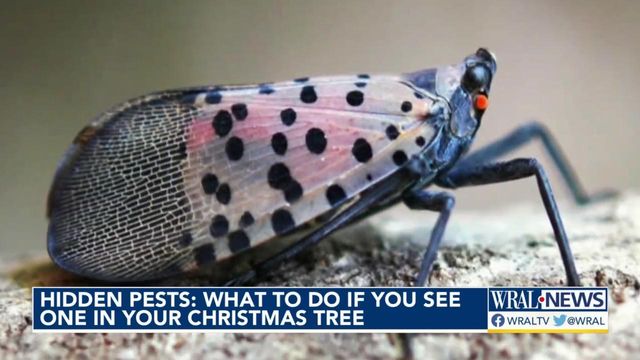Pest believed to be making way to NC could be in Christmas trees
If you're getting ready to buy your Christmas tree, you'll want to be careful! The Department of Agriculture says you may take more than just a tree home.
Posted — UpdatedIf you're getting ready to buy your Christmas tree, you'll want to be careful! The Department of Agriculture says you may take more than just a tree home.
The arrival of the holiday season means experts are keeping a close eye on the Spotted Lanternfly and what you should do if you see one.
The Spotted Lanternfly was first spotted in eastern Pennsylvania in 2014. Experts at the Department of Agriculture have been tracking it ever since. It was recently seen in Virginia and they fear it could soon make its way here.
"We’re on high alert," said Joy Goforth, Plant Pest Administrator with the North Carolina Department of Agriculture. "Once we knew it made it to Virginia, it’s only a matter of time before it made it to North Carolina"
The Spotted Lanternfly does not pose a threat to humans. It's actually quite beautiful. But it's highly destructive to plants and almost impossible to detect. They've been seen in New Jersey, Virginia, Delaware, West Virginia, Maryland, Connecticut, New York, Ohio, Indiana and Massachusetts.
"If you know that your tree is coming from another source, particularly somewhere up north, you have to be very careful with bringing it in the house," Goforth said.
"It’s so highly camouflaged," Goforth said. "It literally is like a spot of mud, and they will lay their eggs on any surface."
The pest can lay its eggs on tree branches, metal surfaces and even vehicle campers. It's a known nuisance to people, businesses, homes and a threat to crops like hops and fruit trees.
"They’re also just really gross and messy, so they don’t have many predators," Goforth said.
Because they are almost impossible to spot, the North Carolina Department of Agriculture is bringing in two detector dogs to track the pest.
"They’ll be able to identify egg masses which are the hardest life stage to find," Goforth said.
The Department of Agriculture is asking that people keep a close eye on the pest. If you think you found one, you're encouraged to report it by taking a picture and sending it to badbug@ncagr.gov.
Kill the bug and, if you can, put it in a Ziplock bag and store it in the freezer until an expert can pick it up.
Related Topics
• Credits
Copyright 2024 by Capitol Broadcasting Company. All rights reserved. This material may not be published, broadcast, rewritten or redistributed.






